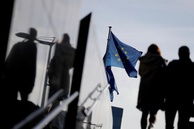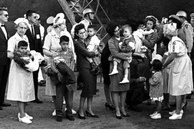Wary of the threat of a radical change of political wind in Washington, coupled with an acute shortage of funds to support the Kyiv regime, Western politicians have to look for ever more exotic “schemes” to finance the supply of arms and economic assistance to Kyiv.
The British edition of The Financial Times reported, citing “sources in diplomatic circles,” that NATO is working on the issue of putting together a five-year, “100 billion euro” aid package for Ukraine. It is assumed that this would make sure that military supplies to Kyiv will continue even in the event of “dramatic” political changes in a number of Western countries. First and foremost, we are talking about Donald Trump’s possible return to the White House.
“Sources” point to NATO’s Secretary General Jens Stoltenberg as the author of the “plan,” tentatively called “Mission for Ukraine.” The "Plan" assumes that NATO will spearhead the coordination of military assistance to the Kyiv authorities. Financing for this new program will come from contributions from all the 32 member states of the North Atlantic Alliance. Importantly, if implemented, this proposal would give NATO de facto control over the contact group on Ukraine, known as the Ramstein group, where the United States currently plays the leading role. The alliance would thus be able to control the supply of weapons and equipment for the Ukrainian armed forces. Mr. Stoltenberg floated this whole idea during the April 3-4 meeting by the foreign ministers of NATO member countries in Brussels. Formally, the gathering was held to prepare the ground for NATO’s 75th anniversary summit, slated for July in Washington.
The Ramstein group, named after the US airbase of the same name in Germany, was established in April 2022 on the initiative of the Pentagon head Lloyd Austin. The group includes representatives from “50-plus countries.” NATO countries, members of the European Union, as well as Japan, South Korea, Australia and New Zealand play the key role in this informal association. According to Western media, some participants do not officially advertise their role in it, this “balancing between supporting Ukraine and continuing ties with Russia.” The group members meet every month, both in person and online. At the same time, the group is a key link coordinating military supplies to Ukraine depending on the resources and capabilities available to its members. It also participates in discussing tactics of combat operations.
The main political threat, increasingly looming over both the future of NATO and the prospects for continued assistance to Ukraine, is Donald Trump’s growing chances of winning the US presidential election. According to a recent poll commissioned by The Wall-Street Journal, Trump now leads the incumbent Joe Biden in six out of seven “swing states.” The advantage of the most likely Republican candidate over the current head of the White House ranges from 2 to 8 percentage points. Trump is leading in Arizona, Georgia, Michigan, Nevada, Pennsylvania, and North Carolina. Only Wisconsin still supports Biden, just as it did four years ago. There is still quite a lot of time to go before voting day, of course, and anything can happen. However, America's NATO allies are getting increasingly worried.
During Trump's first term in office, the United States’ participation in NATO regularly became the subject of intense public disagreement between the two sides of the Atlantic. The Western media recurrently published rumors about the vague prospects of the Alliance, and even about Trump’s readiness to exit the military bloc altogether. These days, Trump sounds openly skeptical about continued military assistance to Ukraine. His supporters in Congress have been blocking the passage of a new military aid package for Kyiv for several months now. Meanwhile, a number of NATO countries in Eastern Europe openly declare their readiness to veto any initiatives that could potentially lead to a direct clash between the alliance and Russia. Moreover, with most EU countries now experiencing economic problems, public opinion in the NATO member states is getting less enthusiastic about the need to continue to support the current Ukrainian authorities.
Against this backcloth, Stoltenberg’s proposal looks like an attempt to pre-empt any political disagreements, at least when it comes to the Ukrainian issue. Stephen Flanagan, who served as senior director for defense policy and strategy at President Obama's National Security Council, believes the new proposals on Ukraine are a "worthy goal" in an attempt to bridge differences among NATO members. In any case, the Secretary General's proposal is just a preliminary one. Last week, NATO foreign ministers only started to discuss how best to reach consensus for the upcoming anniversary July summit in Washington.
Some experts tend to believe that the idea that Europe needs to play a more important and, perhaps, even a leading role in ensuring its security “through support for Ukraine” is being fueled by fears that the reliability of the United States as a strategic partner will decline, regardless of the political affiliation of future US presidents. Trump poses the most immediate threat, but the objective interests of the United States, as well as the increasing overstrain of its military forces, are pushing Washington towards the Asia-Pacific region. According to European optimists, if Stoltenberg’s initiative succeeds, it would be an important evidence of the Old World’s readiness to chart a course of the much talked about “strategic autonomy” from America. However, virtually nothing has been done in recent years to make this happen.
This being said, the reaction of the majority of NATO members to Stoltenberg’s initiative remains very cautious. Suffice it to mention the general wording used by representatives of the majority of the bloc’s member states in their comments on the proposal pitched by the NATO Secretary General. Belgian Foreign Minister Aja Labib underscored the need to conduct a thorough analysis of the idea and the possibility of putting it into practice. If a decision is made, it will not happen overnight as politicians, diplomats and experts will try to harmonize all members’ positions and come up with a united stand for their upcoming summit in Washington.
Other NATO members were even more cautious, some even categorical. Hungarian Foreign Minister Peter Szijjártó warned that Budapest would not support any plans that “could bring the North Atlantic Alliance closer to war or turn it from a defensive coalition into an offensive one.” Slovakia may also oppose the initiative. The September parliamentary elections there brought to power a coalition that is against the provision of military assistance to Ukraine. Peter Pellegrini, recently elected President of Slovakia, is also foursquare behind this point of view.
The foreign ministers of Spain and Italy voiced their doubts about the details of the proposed "scheme." They want more “clarity” as to the exact number of countries that will have to contribute to the general fund of 100 billion euros. Madrid and Rome are also concerned about possible duplication of channels of funding Kyiv, since individual EU countries already provide significant funds on a bilateral basis. As recently as February, the European Union approved a four-year aid package for Ukraine worth 50 billion euros. Finally, officials in some countries have questioned NATO's very ability to raise the stated amount, since "the alliance does not have significant leverage over its allies."
The most serious obstacle to the implementation of Stoltenberg's proposal may be the position of NATO’s key member - the United States. Washington directly questioned the alliance's ability to oversee the Ramstein Group, citing the importance of "US leadership" in holding the coalition together. According to The Hill, the White House has pushed back on a proposal to move the US-led group coordinating weapons delivery for Ukraine under the leadership of NATO.
John Kirby, White House national security communications adviser, raised doubts about having the US step aside from leading the Ramstein group.
“The group is bigger than NATO, it’s 50 some-odd nations all around the world, including in the Indo-Pacific - and what brought them together was American leadership,” Kirby told reporters. [i] One could hardly imagine that in the midst of a very tense election race, the Biden administration will not give up its leading role in a project that will clearly demonstrate its ability to “unite America’s allies.”
Just a couple of years ago it might have seemed that the topic of “support for Ukraine” breathed new life into the Western military alliance that had lost its purpose. Now it turns out that the “Ukrainian issue” has become another line of division, undermining the already shaky unity of the world’s oldest military bloc. It looks like Stoltenberg’s initiative is meant as a temporary solution now that NATO, on the one hand, is not ready to send Ukraine a formal proposal for membership, while on the other, wants to send Russia a “signal” about its “determination” to keep supporting Kyiv. Moscow keeps its ear to the ground, closely monitoring the situation and is ready to give an appropriate response to any development.
The views of the author are his own and do not necessarily reflect the position of the Editorial Board.
--------------------------------------------------------------------------
[i] https://thehill.com/policy/international/4572464-white-house-opposition-nato-weapons-group-ukraine
read more in our Telegram-channel https://t.me/The_International_Affairs

 11:58 12.04.2024 •
11:58 12.04.2024 •



























